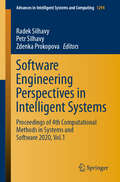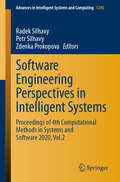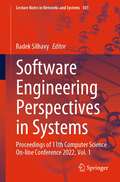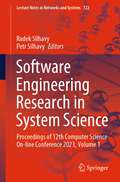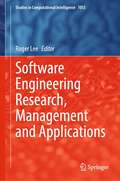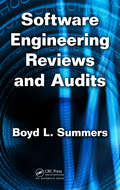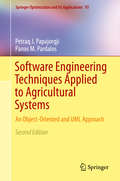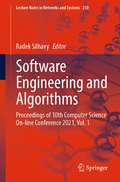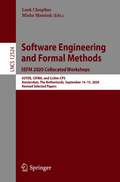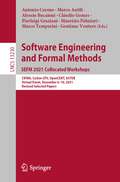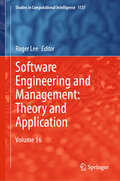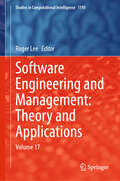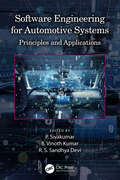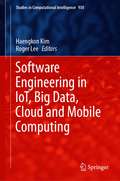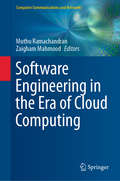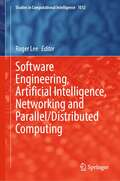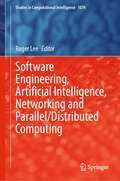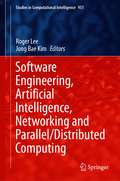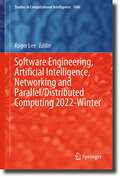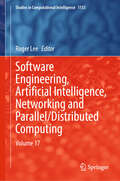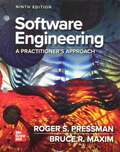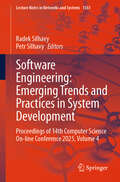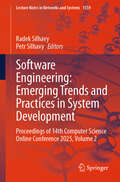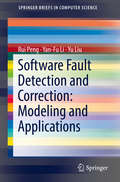- Table View
- List View
Software Engineering Perspectives in Intelligent Systems: Proceedings of 4th Computational Methods in Systems and Software 2020, Vol.1 (Advances in Intelligent Systems and Computing #1294)
by Radek Silhavy Petr Silhavy Zdenka ProkopovaThis book constitutes the refereed proceedings of the 4th Computational Methods in Systems and Software 2020 (CoMeSySo 2020) proceedings. Software engineering, computer science and artificial intelligence are crucial topics for the research within an intelligent systems problem domain. The CoMeSySo 2020 conference is breaking the barriers, being held online. CoMeSySo 2020 intends to provide an international forum for the discussion of the latest high-quality research results.
Software Engineering Perspectives in Intelligent Systems: Proceedings of 4th Computational Methods in Systems and Software 2020, Vol.2 (Advances in Intelligent Systems and Computing #1295)
by Radek Silhavy Petr Silhavy Zdenka ProkopovaThis book constitutes the refereed proceedings of the 4th Computational Methods in Systems and Software 2020 (CoMeSySo 2020) proceedings. Software engineering, computer science and artificial intelligence are crucial topics for the research within an intelligent systems problem domain. The CoMeSySo 2020 conference is breaking the barriers, being held online. CoMeSySo 2020 intends to provide an international forum for the discussion of the latest high-quality research results.
Software Engineering Perspectives in Systems: Proceedings of 11th Computer Science On-line Conference 2022, Vol. 1 (Lecture Notes in Networks and Systems #501)
by Radek SilhavyThe study of software engineering and its applications to system engineering is critical in computer science research. Modern research methodologies, as well as the use of machine and statistical learning in software engineering research, are covered in this book. This book contains the refereed proceedings of the Software Engineering Perspectives in Systems part of the 11th Computer Science On-line Conference 2022 (CSOC 2022), which was held in April 2022 online.
Software Engineering Research in System Science: Proceedings of 12th Computer Science On-line Conference 2023, Volume 1 (Lecture Notes in Networks and Systems #722)
by Radek Silhavy Petr SilhavyThe latest advancements in software engineering are featured in this book, which contains the refereed proceedings of the part of the 12th Computer Science Online Conference 2023 (CSOC 2023), held online in April 2023. The software engineering research in system science session is focusing on the importance of software engineering in the field of system science. This section provides a platform for researchers to share their insights on modern research methodologies, machine learning, and statistical learning techniques in software engineering research. The session provides a unique opportunity for researchers and industry experts to explore the latest trends in software engineering and inspire future research directions. This session brings together experts from different fields to present their research and discuss the latest challenges and opportunities. One of the key themes of this session is the application of artificial intelligence in software engineering. Researchers are exploring how techniques can be used to automate various aspects of software engineering, such as testing, debugging, and maintenance. This helps improve the quality and efficiency of software development processes.
Software Engineering Research, Management and Applications (Studies in Computational Intelligence #1053)
by Roger LeeThis edited book presents scientific results of the 20th IEEE/ACIS International Conference on Software Engineering Research, Management, and Applications (SERA2022) held on May 25, 2022, in Las Vegas, USA. The aim of this conference was to bring together researchers and scientists, businessmen and entrepreneurs, teachers, engineers, computer users and students to discuss the numerous fields of computer science and to share their experiences and exchange new ideas and information in a meaningful way. Research results about all aspects (theory, applications and tools) of computer and information science and to discuss the practical challenges encountered along the way and the solutions adopted to solve them. The conference organizers selected the best papers from those papers accepted for presentation at the conference. The papers were chosen based on review scores submitted by members of the program committee and underwent further rigorous rounds of review. From this second round of review, 12 of the conference’s most promising papers are then published in this Springer (SCI) book and not the conference proceedings. We impatiently await the important contributions that we know these authors will bring to the field of computer and information science.
Software Engineering Reviews and Audits
by Boyd L. SummersAccurate software engineering reviews and audits have become essential to the success of software companies and military and aerospace programs. These reviews and audits define the framework and specific requirements for verifying software development efforts.Authored by an industry professional with three decades of experience, Software Engineerin
Software Engineering Techniques Applied to Agricultural Systems
by Panos M. Pardalos Petraq J. PapajorgjiSoftware Engineering Techniques Applied to Agricultural Systems presents cutting-edge software engineering techniques for designing and implementing better agricultural software systems based on the object-oriented paradigm and the Unified Modeling Language (UML). The focus is on the presentation of rigorous step-by-step approaches for modeling flexible agricultural and environmental systems, starting with a conceptual diagram representing elements of the system and their relationships. Furthermore, diagrams such as sequential and collaboration diagrams are used to explain the dynamic and static aspects of the software system. This second edition includes: a new chapter on Object Constraint Language (OCL), a new section dedicated to the Model-VIEW-Controller (MVC) design pattern, new chapters presenting details of two MDA-based tools - the Virtual Enterprise and Olivia Nova and a new chapter with exercises on conceptual modeling. It may be highly useful to undergraduate and graduate students as the first edition has proven to be a useful supplementary textbook for courses in mathematical programming in agriculture, ecology, information technology, agricultural operations research methods, agronomy and soil science and applied mathematical modeling. The book has broad appeal for anyone involved in software development projects in agriculture and to researchers in general who are interested in modeling complex systems. From the reviews of the first edition: "The book will be useful for those interested in gaining a quick understanding of current software development techniques and how they are applied in practice. . . this is a good introductory text on the application of OOAD, UML and design patters to the creation of agricultural systems. It is technically sound and well written. " --Computing Reviews, September 2006
Software Engineering and Algorithms: Proceedings of 10th Computer Science On-line Conference 2021, Vol. 1 (Lecture Notes in Networks and Systems #230)
by Radek SilhavyThis book constitutes the refereed proceedings of the Software Engineering and Algorithms section of the 10th Computer Science On-line Conference 2021 (CSOC 2021), held on-line in April 2021. Software engineering research and its applications to intelligent algorithms take an essential role in computer science research. In this book, modern research methods, application of machine and statistical learning in the software engineering research are presented.
Software Engineering and Formal Methods. SEFM 2020 Collocated Workshops: ASYDE, CIFMA, and CoSim-CPS, Amsterdam, The Netherlands, September 14–15, 2020, Revised Selected Papers (Lecture Notes in Computer Science #12524)
by Mieke Massink Loek CleophasThis volume constitutes the revised selected papers from the three workshops collocated with the 18th International Conference on Software Engineering and Formal Methods, SEFM 2020, held in Amsterdam, The Netherlands, in September 2020. The 15 full papers presented together with 8 short papers in this volume were carefully reviewed and selected from a total of 35 submissions. The contributions that are collected in this volume have been selected from the presentations at the following workshops: ASYDE 2020: Second International Workshop on Automated and Verifiable Software System Development; CIFMA 2020: Second International Workshop on Cognition: Interdisciplinary Foundations, Models and Applications; and CoSim-CPS 2020: Fourth International Workshop on Formal Co-Simulation of Cyber-Physical Systems. Due to the Corona pandemic this event was held virtually.
Software Engineering and Formal Methods. SEFM 2021 Collocated Workshops: CIFMA, CoSim-CPS, OpenCERT, ASYDE, Virtual Event, December 6–10, 2021, Revised Selected Papers (Lecture Notes in Computer Science #13230)
by Antonio Cerone Pierluigi Graziani Marco Temperini Gentiane Venture Marco Autili Alessio Bucaioni Cláudio Gomes Maurizio PalmieriThis volume constitutes revised selected papers from the four workshops collocated with the 19th International Conference on Software Engineering and Formal Methods, SEFM 2021, held virtually during December 6–10, 2021.The 21 contributed papers presented in this volume were carefully reviewed and selected from a total of 29 submissions. The book also contains 3 invited talks.SEFM 2021 presents the following four workshops:CIFMA 2021 - 3rd International Workshop on Cognition: Interdisciplinary Foundations, Models and Applications;CoSim-CPS 2021 - 5th Workshop on Formal Co-Simulation of Cyber-Physical Systems;OpenCERT 2021 - 10th International Workshop on Open Community approaches to Education, Research and Technology;ASYDE 2021 - 3rd International Workshop on Automated and verifiable Software sYstem Development.Due to the Corona pandemic this event was held virtually.
Software Engineering and Management: Volume 16 (Studies in Computational Intelligence #1137)
by Roger LeeThe book reports state of the art results in Software Engineering Research, Management & Applications in both printed and electronic form. SCI (Studies in Computation Intelligence) has grown into the most comprehensive computational intelligence research forum available in the world.This volume published original papers on both theory and practice that address foundations, state of the art problems and solutions, and crucial challenges.
Software Engineering and Management: Volume 17 (Studies in Computational Intelligence #1193)
by Roger LeeThis book reports state-of-the-art results in Software Engineering Research, Management & Applications in both printed and electronic form. Studies in Computation Intelligence (SCI) has grown into the most comprehensive computational intelligence research forum available in the world. This book published original papers on both theory and practice that address foundations, state-of-the-art problems and solutions, and crucial challenges.
Software Engineering for Automotive Systems: Principles and Applications
by P. SivakumarSoftware Engineering for Automotive Systems: Principles and Applications discusses developments in the field of software engineering for automotive systems. This reference text presents detailed discussion of key concepts including timing analysis and reliability, validation and verification of automotive systems, AUTOSAR architecture for electric vehicles, automotive grade Linux for connected cars, open-source architecture in the automotive software industry, and communication protocols in the automotive software development process. Aimed at senior undergraduate and graduate students in the fields of electrical engineering, electronics and communication engineering, and automobile engineering, this text: Provides the fundamentals of automotive software architectures. Discusses validation and verification of automotive systems. Covers communication protocols in the automotive software development process. Discusses AUTOSAR architecture for electric vehicles. Examines open-source architecture in the automotive software industry.
Software Engineering for Image Processing Systems
by Philip A. LaplanteSoftware Engineering for Image Processing Systems creates a modern engineering framework for the specification, design, coding, testing, and maintenance of image processing software and systems. The text is designed to benefit not only software engineers, but also workers with backgrounds in mathematics, the physical sciences, and other engineering
Software Engineering in IoT, Big Data, Cloud and Mobile Computing (Studies in Computational Intelligence #930)
by Roger Lee Haengkon KimThis edited book presents scientific results of the International Semi-Virtual Workshop on Software Engineering in IoT, Big data, Cloud and Mobile Computing (SE-ICBM 2020) which was held on October 15, 2020, at Soongsil University, Seoul, Korea. The aim of this workshop was to bring together researchers and scientists, businessmen and entrepreneurs, teachers, engineers, computer users, and students to discuss the numerous fields of computer science and to share their experiences and exchange new ideas and information in a meaningful way. Research results about all aspects (theory, applications and tools) of computer and information science, and to discuss the practical challenges encountered along the way and the solutions adopted to solve them. The workshop organizers selected the best papers from those papers accepted for presentation at the workshop. The papers were chosen based on review scores submitted by members of the program committee and underwent further rigorous rounds of review. From this second round of review, 17 of the conference’s most promising papers are then published in this Springer (SCI) book and not the conference proceedings. We impatiently await the important contributions that we know these authors will bring to the field of computer and information science.
Software Engineering in the Era of Cloud Computing (Computer Communications and Networks)
by Zaigham Mahmood Muthu RamachandranThis book focuses on the development and implementation of cloud-based, complex software that allows parallelism, fast processing, and real-time connectivity. Software engineering (SE) is the design, development, testing, and implementation of software applications, and this discipline is as well developed as the practice is well established whereas the Cloud Software Engineering (CSE) is the design, development, testing, and continuous delivery of service-oriented software systems and applications (Software as a Service Paradigm). However, with the emergence of the highly attractive cloud computing (CC) paradigm, the tools and techniques for SE are changing. CC provides the latest software development environments and the necessary platforms relatively easily and inexpensively. It also allows the provision of software applications equally easily and on a pay-as-you-go basis. Business requirements for the use of software are also changing and there is a need for applications in big data analytics, parallel computing, AI, natural language processing, and biometrics, etc. These require huge amounts of computing power and sophisticated data management mechanisms, as well as device connectivity for Internet of Things (IoT) environments. In terms of hardware, software, communication, and storage, CC is highly attractive for developing complex software that is rapidly becoming essential for all sectors of life, including commerce, health, education, and transportation. The book fills a gap in the SE literature by providing scientific contributions from researchers and practitioners, focusing on frameworks, methodologies, applications, benefits and inherent challenges/barriers to engineering software using the CC paradigm.
Software Engineering, Artificial Intelligence, Networking and Parallel/Distributed Computing (Studies in Computational Intelligence #1012)
by Roger LeeThis book presents scientific results of the 22nd ACIS International Fall Virtual Conference on Software Engineering, Artificial Intelligence, Networking and Parallel/Distributed Computing (SNPD2021-Fall) which was held on November 24–26, 2021, at Taichung, Taiwan. The aim of this conference was to bring together researchers and scientists, businessmen and entrepreneurs, teachers, engineers, computer users, and students to discuss the numerous fields of computer science and to share their experiences and exchange new ideas and information in a meaningful way. Research results about all aspects (theory, applications and tools) of computer and information science, and to discuss the practical challenges encountered along the way and the solutions adopted to solve them.The conference organizers selected the best papers from those papers accepted for presentation at the conference. The papers were chosen based on review scores submitted by members of the program committee and underwent further rigorous rounds of review. From this second round of review, 13 of most promising papers are then published in this Springer (SCI) book and not the conference proceedings. We impatiently await the important contributions that we know these authors will bring to the field of computer and information science.
Software Engineering, Artificial Intelligence, Networking and Parallel/Distributed Computing (Studies in Computational Intelligence #1074)
by Roger LeeThis book presents scientific results of the 23rd ACIS International Summer Virtual Conference on Software Engineering, Artificial Intelligence, Networking and Parallel/Distributed Computing (SNPD2022-Summer) which was held on July 4-6, 2022, at Kyoto City, Japan. The aim of this conference was to bring together researchers and scientists, businessmen and entrepreneurs, teachers, engineers, computer users, and students to discuss the numerous fields of computer science and to share their experiences and exchange new ideas and information in a meaningful way. Research results about all aspects (theory, applications, and tools) of computer and information science and to discuss the practical challenges encountered along the way and the solutions adopted to solve them. The conference organizers selected the best papers from those papers accepted for presentation at the workshop. The papers were chosen based on review scores submitted by members of the program committee and underwent further rigorous rounds of review. From this second round of review, 15 of most promising papers are then published in this Springer (SCI) book and not the conference proceedings. We impatiently await the important contributions that we know these authors will bring to the field of computer and information science.
Software Engineering, Artificial Intelligence, Networking and Parallel/Distributed Computing (Studies in Computational Intelligence #951)
by Roger Lee Jong Bae KimThis edited book presents scientific results of the 21st ACIS International Winter Conference on Software Engineering, Artificial Intelligence, Networking and Parallel/Distributed Computing (SNPD2021-Winter) which was held on January 28–30, at Ho Chi Minh City, Vietnam. The aim of this conference was to bring together researchers and scientists, businessmen and entrepreneurs, teachers, engineers, computer users, and students to discuss the numerous fields of computer science and to share their experiences and exchange new ideas and information in a meaningful way and research results about all aspects (theory, applications, and tools) of computer and information science, and to discuss the practical challenges encountered along the way and the solutions adopted to solve them.The conference organizers selected the best papers from those papers accepted for presentation at the conference. The papers were chosen based on review scores submitted by members of the program committee and underwent further rigorous rounds of review. From this second round of review, 18 of most promising papers are then published in this Springer (SCI) book and not the conference proceedings. We impatiently await the important contributions that we know these authors will bring to the field of computer and information science.
Software Engineering, Artificial Intelligence, Networking and Parallel/Distributed Computing 2022-Winter (Studies in Computational Intelligence #1086)
by Roger LeeThis edited book presents scientific results of the 24th ACIS International Winter Conference on Software Engineering, Artificial Intelligence, Networking and Parallel/Distributed Computing (SNPD2022-Summer) which was held on December 7–9, 2022, at Taichung, Taiwan. The aim of this conference was to bring together researchers and scientists, businessmen and entrepreneurs, teachers, engineers, computer users, and students to discuss the numerous fields of computer science and to share their experiences and exchange new ideas and information in a meaningful way. The conference organizers selected the best papers from those papers accepted for presentation at the workshop. The papers were chosen based on review scores submitted by members of the program committee and underwent further rigorous rounds of review. From this second round of review, 15 of the most promising papers are then published in this Springer (SCI) book and not the conference proceedings.
Software Engineering, Artificial Intelligence, Networking and Parallel/Distributed Computing: Volume 17 (Studies in Computational Intelligence #1153)
by Roger LeeThis book reports state-of-the-art results in Software Engineering, Artificial Intelligence, Networking and Parallel/Distributed Computing. This edited book presents original papers on both theory and practice. It addresses foundations, state-of-the-art problems and solutions, and crucial challenges.
Software Engineering: A Practitioner's Approach
by Bruce R. Maxim Roger S. PressmanFor almost four decades, Software Engineering: A Practitioner's Approach (SEPA) has been the world's leading textbook in software engineering. The ninth edition represents a major restructuring and update of previous editions, solidifying the book's position as the most comprehensive guide to this important subject.
Software Engineering: Proceedings of 14th Computer Science On-line Conference 2025, Volume 4 (Lecture Notes in Networks and Systems #1561)
by Radek Silhavy Petr SilhavyThis book discovers peer-reviewed research from an international research conference that unites experts in software engineering, data science, artificial intelligence, cybernetics, and informatics. This book presents cutting-edge methods, practical case studies, and foundational advances that address real-world challenges across the computational spectrum. Whether you seek rigorous theory, proven development practices, or visionary perspectives on emerging technologies, this book provides a comprehensive resource for researchers, practitioners, and students committed to shaping the future of digital systems.
Software Engineering: Proceedings of 14th Computer Science Online Conference 2025, Volume 2 (Lecture Notes in Networks and Systems #1559)
by Radek Silhavy Petr SilhavyThis book discovers peer-reviewed research from an international research conference that unites experts in software engineering, data science, artificial intelligence, cybernetics, and informatics. This book presents cutting-edge methods, practical case studies, and foundational advances that address real-world challenges across the computational spectrum. Whether you seek rigorous theory, proven development practices, or visionary perspectives on emerging technologies, this book provides a comprehensive resource for researchers, practitioners, and students committed to shaping the future of digital systems.
Software Fault Detection and Correction: Modeling and Applications (SpringerBriefs in Computer Science)
by Yu Liu Rui Peng Yan-Fu LiThis book focuses on software fault detection and correction processes, presenting 5 different paired models introduced over the last decade and discussing their applications, in particular to determining software release time. The first work incorporates the testing effort function and the fault introduction process into the paired fault detection and fault correction models. The second work incorporates fault dependency, while the third adopts a Markov approach for studying fault detection and correction processes. The fourth work considers the multi-release property of various software, and models fault detection and correction processes. The last work classifies faults into four types and models the fault-detection and correction processes. Enabling readers to familiarize themselves with how software reliability can be modeled when different factors need to be considered, and how the approaches can be used to analyze other systems, the book is important reference guide for researchers in the field of software reliability engineering and practitioners working on software projects. To gain the most from the book, readers should have a firm grasp of the fundamentals of the stochastic process.
